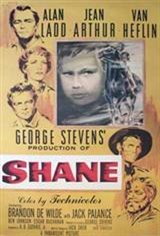Shane

Rotten Tomatoes® Score
![]() 97%
97%
![]() 81%
81%
| In Theaters: |
|
1h 58m | Drama, Western
The simple story of a Wyoming range war is elevated to near-mythical status in producer/director George Stevens' Western classic Shane. Alan Ladd plays the title character, a mysterious drifter who rides into a tiny homesteading community and accepts the hospitality of a farming family. Patriarch Joe Starrett (Van Heflin) is impressed by the way Shane handles himself when facing down the hostile minions of land baron Emile Meyer, though he has trouble placing his complete trust in the stranger, as his Marion (Jean Arthur) is attracted to Shane in spite of herself, and his son Joey (Brandon De Wilde) flat-out idolizes Shane. When Meyer is unable to drive off the homesteaders by sheer brute strength, he engages the services of black-clad, wholly evil hired gun Jack Wilson (Jack Palance). The moment that Wilson shows he means business by shooting down hotheaded farmer Frank Torrey (Elisha Cook Jr.) is the film's most memorable scene: after years of becoming accustomed to carefully choreographed movie death scenes, the suddenness with which Torrey's life is snuffed out -- and the force with which he falls to the ground -- are startling. Shane knows that a showdown with Wilson is inevitable; he also knows that, unintentionally, he has become a disruptive element in the Starrett family. The manner in which he handles both these problems segues into the now-legendary Come back, Shane finale. Cinematographer Loyal Griggs imbues this no-frills tale with the outer trappings of an epic, forever framing the action in relation to the unspoiled land surrounding it. A.B. Guthrie Jr.'s screenplay, adapted from the Jack Schaefer novel, avoids the standard good guy/bad guy clichés: both homesteaders and cattlemen are shown as three-dimensional human beings, flaws and all, and even ostensible villain Emile Meyer comes off reasonable and logical when elucidating his dislike of the newcomers who threaten to divest him of his wide open spaces.
